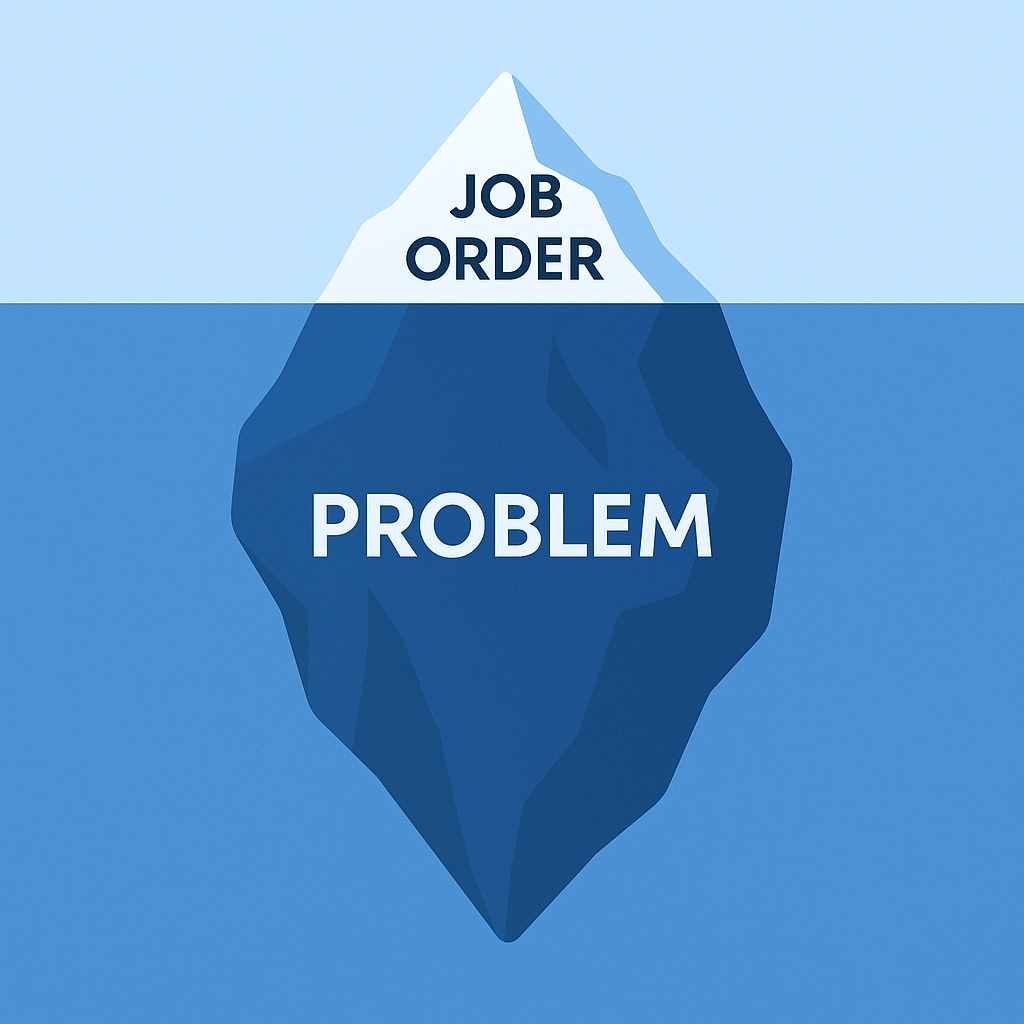Selling With Your Consultant
In my previous post, How to Prevent Unexpected Contract Terminations, I shared how systemizing consultant and client check-ins at key milestones...
5 min read
![]() Dan Fisher
:
Feb 16, 2021 8:07:59 AM
Dan Fisher
:
Feb 16, 2021 8:07:59 AM

2020 was the year of adjustment. The Covid-19 pandemic taught us that nothing is for certain and that we must be agile in order to survive and thrive. Perhaps that is why the 50+ C-level staffing industry executives I have spoken with this year have all shared with me that they have numerous growth initiatives planned for 2021.
Launching an internal initiative is a common way for leaders to give their business a leg up on the competition and boost growth. After all, there are always better ways of doing things and no organization can stand still after last year. But far too many “initiatives” fail to deliver the intended results.
Consider implementing a new sales software tool. Depending on the tool, the technical side of implementing the software can be complex or relatively easy, especially if it is a SaaS product. You configure the tool, create some use cases to test it's application and run through mock-up workflows. But its the process of getting your people on board and adopting the tool that makes the difference between success and failure. Why? To extract value from the tool, individuals will need to perform their jobs differently. The degree to which they change their behaviors and adopt the new tool will have a significant impact on the initiative. This is why today's modern sales leader must understand change management how to effectively lead organizational change.
In this blog I'm going to share with you why corporate initiatives fail and five steps to ensuring your 2021 initiatives deliver results.
Change Management 101
Change management focuses on managing the people side of change. Rolling out a new initiative such as a new idea, sales tool, process or idea may never see it's full potential if you fail to bring your people along. That's because financial success depends on the degree to which your people embrace the change and adopt the new tool, idea, process, message or strategy. Change management focuses helping employees embrace, adopt and utilize a change in their day-to-day work routine. Change management is both a process and a competency.
You might be thinking, why wouldn't people want to embrace change? After all, change is going to help them and the company grow. Well, most people don't like change. People naturally resist changes to their daily work routines and comfortable work behaviors. Introducing new ideas, systems, processes, skills, behaviors, methodologies and mindsets into an individual’s role including how to perform their job create uncertainty and stress.
Below are a just a few examples of the common fears and concerns running through the minds of employees about to experience a change to their comfortable work routine.
As you roll out your 2021 initiatives you will need to create and execute a plan for effectively addressing and overcoming these concerns and ensure you bring your people along with you during times of change.
Five Steps to Ensuring Your 2021 Initiatives Deliver Results
1.) Define, Commit To and Communicate Your Change Vision. Far too often corporate stakeholders launch an initiative without first discussing, debating and agreeing on what specifically is changing and why. They fail to clearly define what the “future state” looks like. They just assume as a leadership team that they're all on the same page. Leaders don’t realize they’re not on the same page until until it is too late, post implementation launch. By then employees already see the lack of alignment and conflicting communication from the top. The initiative has already failed before ever getting off the ground.
Key Takeaway: Leaders need to engage in a commitment assessment to self assess their level of commitment to the change on a continuum. All leaders must weigh-in and engage in healthy debate until they define a clear and unambiguous vision for the future state (change vision) and each stakeholders level of commitment to achieving that vision. Without 100% commitment from all stakeholders, your initiative is destined to fail before it ever begins.
Your change vision provides your organization with a picture of what the future looks like after the change has been implemented and adopted. Your change vision defines your current state and your desired future state and answers key questions for stakeholders and employees such as; what is changing and why, who will be affected by the change, why we should let go of the past, how the sacrifices and hard work (today) will benefit employees, customers, and/or partners in the future. Your change vision creates clear expectations of what successful change looks like.
2.) Clearly Communicate The Need for Change (to the company). I often see leaders ask their salespeople or recruiters to adopt new tools, participate in training and/or try new approaches without first communicating, discussing and agreeing on the need for change. If your employees first don’t recognize and agree on the need for change you will struggle to get their buy-in and it will feel like a constant battle day in and day out.
Key Takeaway: You can communicate the need for change by facilitating a series of team meetings in which you lead with questions to solicit their input. By leading with questions you can solicit feedback from your employees to share with you the obstacles that are holding them and the company back from further growth and/or productivity. In essence, you let your employees define the need for change including what needs to change and why. It is far easier to get employees to buy into their own ideas then convincing them of your own. This is empowerment at it’s finest.
3.) Communicate Clear Expectations of What Successful Change Looks Like. You have to clearly define and the communicate what you expect of your employees. This means defining what you expect them to do that is different from what they’re currently doing. This also means defining how they will do things differently from how they currently do things. Specificity is key. Consider the struggle sales leaders and recruiting leaders have with getting their team members to document notes in their CRM/ATS.
Key Takeaway: Begin by documenting the “current state” including the “what’ and the “how.” Then document the desired future state including what it is you want your people to do differently and how they are to complete it including how it differs from the current process. Be sure you define what success looks like when you’ve “arrived” (when change is fully adopted). Leaders must also be clear in defining how the change will benefit employees and customers.
4.) Define a Measurement System for How Successful Change, Adoption Will Be Measured. We’ve all heard the old management adage, what can’t be measured can’t be managed. Once you define what successful change looks like you have to develop a system for how it will be tracked, measured and adopted. You can’t just assume it will magically happen.
Key Takeaway: Implement systems that will give you insight into user adoption. Your metrics will vary depending on your change vision and your objectives. But you can use change readiness surveys, change heatmaps, and organizational change readiness assessments. What is most important is that you track how well and to what degree users are implementing, using and/or adopting the new process, tools, idea, training, or policies and that you gain insight from the data to iterate and improve.
5.) Sustaining Change Through Consistent Communication
A common mistake in the pursuit of transformational change is an overemphasis on the “launch” of the new idea, skill, behavior, methodology or process, and an under emphasis on the post launch reinforcement activities required to sustain and solidify the change. So how do you achieve lasting results? The answer is committing to the “sustain” phase.
“Sustain” encompasses all the activities post "launch" launch that integrate tangible change into your organization’s culture – making your new strategy, message, methodology, process, behavior or skill part of what you do and how you do it.
Key Takeaway: Create a communication plan. A communication plan is a detailed listing of audiences, messages and specific communication vehicles that are necessary to build individual and organizational commitment to change. The purpose of the communication plan is to systematically identify, implement and assess communications.
Successful Outcomes
Sample communication vehicles may include all-hands meeting, brown bag lunch, staff/departmental meetings, podcast, broadcasts, video conference, newsletters, one-on-one meetings, email, posters, videos, etc.
This sounds like a lot of work because it is a lot of work. It will especially feel like extra work for your front line managers because they're already crazy busy. Getting them to take ownership of a change initiative and doing the necessary groundwork required to sustain long term change is difficult. But these supporting activities lead to application which lead to habits which lead to results. You’ll need an action plan that accounts for these types of activities to ensure your 2021 initiatives meet expectations and deliver ROI. Click here for additional tips on how to sustain lasting change

In my previous post, How to Prevent Unexpected Contract Terminations, I shared how systemizing consultant and client check-ins at key milestones...

About a year ago, I was serving as the fractional revenue leader, managing sales and recruiting for a client.

If you’ve worked in staffing long enough, you’ve been trained to chase job orders.